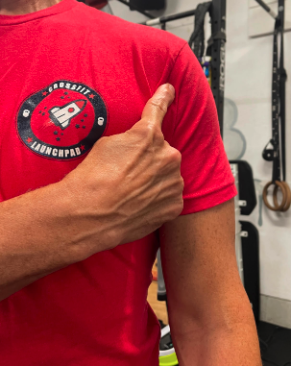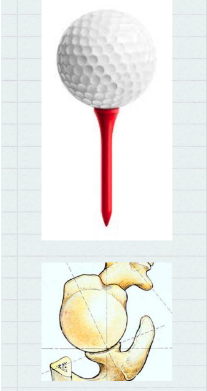The CrossFit coach is tasked with a multitude of responsibilities. When it comes to athletes’ health, coaches are looked to for answers and best practices. The goal of this article is to help answer some of the questions athletes might have when it comes to shoulder health.
The easiest tool a coach has when it comes to assessing their athletes is to get a history of any issues, injuries, or surgeries they may have had in the past. Somebody who mentions that their shoulder dislocates every time they reach overhead is going to need a much different on-ramp than someone who has no prior history of injury.
I will go through a few of the most common conditions I see as a coach and orthopedic surgeon and ways coaches can help their athletes.
Overuse
The classic and most common example of shoulder pain comes from mere overuse, leading to tendinitis or tendinopathy. This can occur in any tendon in the shoulder, such as the biceps or rotator cuff. It is most commonly seen in the biceps tendon in the front of the shoulder.
 When seen in the rotator cuff, the four tendons surrounding the shoulder, tendinitis pain usually is described as occurring down the lateral, or outer, side of the arm.
When seen in the rotator cuff, the four tendons surrounding the shoulder, tendinitis pain usually is described as occurring down the lateral, or outer, side of the arm.
Tendinitis starts as a result of a change in activity, often seen at the beginning of one’s CrossFit journey. Lifting medium to heavy weights and moving them overhead are movements that someone new to CrossFit may not have done before. So, these tendons become stressed and develop microscopic tears in the tendon structures. Symptoms include pain with reaching or lifting off to the side or in front of them. The simplest and most effective treatment for this is to modify activities until the tendons heal. Some people will push through this pain, which unfortunately exacerbates their symptoms and worsens the microtears. This ultimately leads to a longer healing process. Something that would easily take two or three weeks to quiet down on its own could take three to four months to heal if someone is not careful.
The goal is to limit activities that are painful and to make sure the pain does not recur the next day — if it does, you did too much the day before. It’s a process that requires some experimentation — but the great news for CrossFit athletes is that over time, tendons can adapt to the stress and become stronger, which decreases the risk of tendinitis.
This makes it abundantly clear that following CrossFit’s charter of mechanics, then consistency, and then intensity is of the utmost importance. In addition, ensure that workout programming is not excessively redundant with movement functions on a day-to-day basis.
Shoulder Instability

Photo courtesy of 321GoMD.com
Instability of the shoulder is a very common occurrence because of the anatomy of the ball and socket of the shoulder. The shoulder joint consists of a very large ball in a very small, shallow socket, which allows it to move in many directions.
If the movement is stressed to the point where something can tear or shift, that is called a shoulder subluxation or dislocation. This is frequently seen in athletes who dive onto their shoulders or have their arm pulled back while guarding or tackling another opponent. In CrossFit, this position can occur with a snatch, during kipping pull-ups, or anytime the arm is in the overhead position.
If someone tells you they have a history of instability and says their shoulder feels loose, then I would be very cautious with heavy overhead weights. You should start slowly working on the muscles around the shoulder joint in a controlled situation versus high-velocity, explosive movements. Focus on movements like strict presses and push presses and avoid movements such as loaded snatches, where there is an aggressive pull into an overhead position with weight. For gymnastics movements, ensure that athletes can demonstrate the strict variations of the movements prior to kipping variations. In the overhead position, the ligaments in the front of the shoulder keep the ball and socket in place. If someone has a loose ligament in the front of the shoulder or a labral tear, the shoulder could slip out of position.
Acute Injury

Photo courtesy of 321GoMD.com
More obvious — and fortunately, less frequent — scenarios occur when someone feels a rip, tear, or pop and is unable to move their arm very well. Depending on the age of the patient, younger people are more likely to have labral tears whereas older people are more likely to sustain rotator-cuff tears. For the older person with a sudden injury and difficulty reaching in front or lifting their arm to the side or behind them, this would be time for a referral to a healthcare professional looking for a possible rotator cuff tear.
Address, Don’t Overlook
The CrossFit coach can be a very useful resource to their athletes, and having the knowledge and experience of coaching many people over time can help future clients. When dealing with aches or pains, the model remains simple: Obtain someone’s history, modify when someone develops pain, work in pain-free ranges of motion, and refer when needed. Anyone who exercises can develop aches and pains. Actively addressing them instead of overlooking them will show the athlete and gym members that you as a coach are looking out for their best interests, their long-term health, and overall well-being.
Cover photo by Charlotte Foerschler
about the author
 Sean Rockett, M.D., is an orthopedic surgeon and senior partner of Orthopedics New England in Natick, Massachusetts. Dr. Rockett is a CrossFit Level 2 Trainer and co-owner of CrossFit Launchpad. He also enjoys being the head orthopedic surgeon of the CrossFit Games Medical team. He is the author of the health blog 321gomd.com.
Sean Rockett, M.D., is an orthopedic surgeon and senior partner of Orthopedics New England in Natick, Massachusetts. Dr. Rockett is a CrossFit Level 2 Trainer and co-owner of CrossFit Launchpad. He also enjoys being the head orthopedic surgeon of the CrossFit Games Medical team. He is the author of the health blog 321gomd.com.
Shoulder Pain Evaluation for the CrossFit Coach